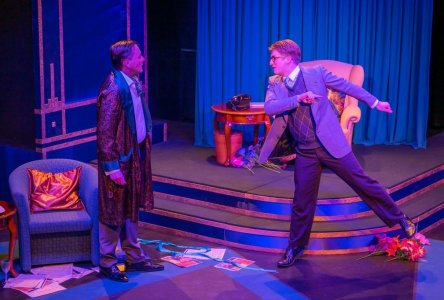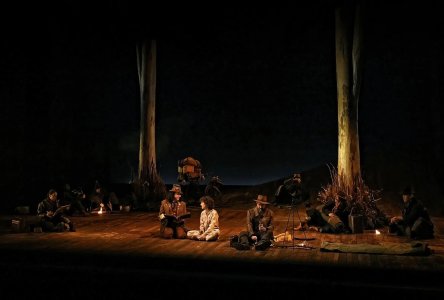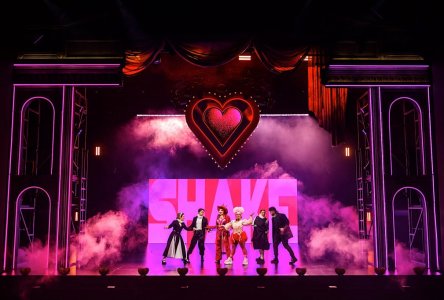
THE ARTS AND THE COMMON GOOD
The Arts and the Common Good - an extract from the latest Currency House Platform Paper. By Katharine Brisbane AM. (Get it from www.currencyhouse.org.au). Photograph by Patrick Boland (right) and above, the great mathematician, Luca Pacioli.
After 50 years watching and commentating on the arts and culture of Australia, Katharine Brisbane has strong things to say about where we’ve been, where we are now and where we should be heading. She writes:
“My aim has been to question the sector’s inherited reluctance to recognise profit as an honest motive and find new ways to give each performance the maximum advantage and life by enabling realistic upfront time and costs, collaboration, investment, shared resources and planning; and good transparent accounting.
“Ian Youngs, a BBC arts reporter, in a recent survey of UK theatre, was surprised to find that despite their severe funding cuts from 2009, British theatre was thriving. Back in 1985 director Trevor Nunn had brought down scandal on the Royal Shakespeare Company by partnering with impresario Cameron Macintosh to create Les Misérables, the musical.
“Today the National and other UK subsidised companies are earning millions in royalties from shows they have developed and transferred:
‘There is a premier league of leading subsidised theatre companies that can take their hit shows to the West End, to Broadway and into cinemas, attract private funding and lure top talent. And the gap between that top tier and the other publicly-funded theatres is growing… I was expecting to find a story about theatres cutting production numbers and new writing. What has emerged is a different story …they have become more efficient, more resourceful and more entrepreneurial.’
“I believe that a genuinely collaborative theatre industry could plan and develop work that would have a longer life than at present is possible. And that there should be a place for every form within it: opera, drama, comedy, dance musicals, circus, children’s theatre, puppetry and so on.
“What if the not-for-profit status was removed from the equation? What if the Federal Government gave the Major Performing Arts Companies a handshake worth six years’ subsidy and told them to rethink their mission, restructure their company and invite investment? State theatres and opera houses could then become metropolitan theatres, available for hire; their maintenance the responsibility of their owner (the State Government). The state companies, now cashed up and relieved of maintenance pressure, could reconsider their work in an atmosphere of new possibility, healthy competition and the profit motive.
“Then, what if a national theatre company – or workshop – was available? To select and examine texts, develop productions, run a short try-out season, perhaps a second one, and then put the shows up for auction? The necessary preparation done, they have the opportunity to become part of the major theatres repertoire or be publicly produced, either in the arts centres or the city theatres.
“Similarly, why should the subsidised sector not apply their experience also to building a music theatre industry and benefit as an investor? Music theatre generated $1.2 billion in Australia in 2013-14: investment is needed to take the leap forward. John Senczuk in his recent Platform Paper outlines the long and complex process needed to make a successful musical and proposes Perth as a city with the will and resources to accomplish this.
“What would this mean for our ‘high art’? Would it mean a rush of popular overseas successes at the expense of local art? It’s a possibility for a while but with the revival of a risk-taking culture, new opportunities for collaboration, employment, and the development of work to greater fulfilment, together with new places in which to play, would not the whole landscape of work practice be transformed?
“The key to this is the artistic director. The sign of a healthy theatre is an artistic director with an identifiable purpose, who is seen, heard and answerable to the company and the public, and is unquestionably the cornerstone of a collegiate organisation. Otherwise to all the members it becomes a job. Today the annual seasons too often look like the work of a committee allocating the budget: a classic or two, a star or two, a hit comedy or drama and a cautious exploration of some new or near-new local works.
“What then would the Australia Council be doing in this scenario? Investing in innovation and quality at all levels: supporting the national theatre workshop, sustaining our tradition and community, and developing high-risk individual talent. Addressing artists’ needs by supporting them with travel and work projects, subsidising research, risk-taking and long-term development; answering needs other than major production.
“Here are my proposals:
“1. A real industry
“I believe that we have the potential for a profit-based performance industry of the highest quality. At present we have large state theatre companies and national opera and ballet. And medium-level companies with their own theatres of varying capacity; and a repertoire individual to themselves. Our small public industry is largely excluded from the art centres, their newer theatres are mostly limited by being attached to casino complexes; and the remaining JCW theatres are shabby. If a level of interchange and collaboration could be achieved in terms of long-term national investment, the resources would go much further.
“2. National development
“I believe that we need a national theatre workshop dedicated to developing an Australian performance tradition and working with playwrights to bring the text, performance and design to its optimum before public performance. Such a workshop, with its own residential facilities and theatre space away from the major city centres, could reduce the cost and intensity of rehearsal timetables and produce a finished blueprint for a designated company or the market. The present developmental programs are single purpose initiatives and have limited capacity to engage in long-run development. In the proposed envi- ronment it could in time grow its own studio audience.
“3. Rethought venues

“I believe that it is now time for our performing arts centres to become metropolitan theatres open for hire. While they would still have their home in their arts centre, the state companies could also be free to choose other locations, and try out some of their work in smaller centres before expanding to their regular season. I believe the arts centres should become ‘second step’ houses, capable of expanding a work from a small theatre to a large one; one that has the resources to display the goods of which our playwrights, directors, choreographers and performers are capable. The brief should include participating in the work of the national workshop enterprise established to develop and tour the Australian repertoire.
“4. Refocussed Australia Council
“I believe that the Australia Council should be redrafted to invest their money in talent, employment, assisting individual artists, funding innovation and advancing the interests of cultural continuity and self-examination. Supporting the national workshop would be one of its responsibilities. In setting up the Australia Council there was little risk, or expectation outside normal industry practice; the vision was authentic but neither practical at the time nor nationally challenging. To date the Council’s history has been one of experiment and change in their management of the professional arts but of very little daring in the development of creative process.
“5. Cultural leadership
“I believe that our major artists should take their place at the head of the profession as advocates and spokesmen and women; should actively promote their industry’s practice and social value; and be retained by and identified with their particular arts organisation or company not through occasional appearances but for a year at a time. Cate Blanchett set an example as both co-artistic director and star of the Sydney Theatre Company. An executive position is not required but a Board position should be, from which they could speak as an informed and eloquent representative of an important company and responsible profession.
“6. Outside funding
“I believe that the Australian performing arts have more than enough talent and vision to attract their second-step development venture capital and the ethical investment sector. Having been forced into a monetarist system by rising costs, our performance companies have learnt to exercise their talents in a commercial environment, have sought out investors, been judged by the quality, reach and price of their product. Their greatest asset, the one that has brought this about, is the innate value they offer both business and the nation — the unique talent of their artists. It is a gift that money cannot buy but can be awarded, and rewarded, if the conditions are right.
“My proposals are not prescriptive, just ruminations on what could be possible, and aimed at making the most of all the initiatives already happening in our wide brown land, breaking down the frustrations that derive from uncertainty and the constraints imposed by a long held belief in the separation of art and commerce.
“So, how to we begin?
“First by facing the past and recognising that working harder on the same treadmill will not change the outcome. Nor can we go on asking Government to ‘do something’. The Australia Council has taken some giant steps to re-examine its processes and we shall see what comes of that. But it’s time the arts sector itself took charge of its past, present and future.
“The Federal Government has never accepted a brief to understand the arts; and few members have had more than a consumer interest. Nor should we have expected more. The Australia Council was engineered by a group of Canberra entrepreneurs faced with a failing public institution responsible for a disparate collection of semi-amateur organisations; who in an unprepared but politically astute stroke achieved the basis for an NGO that could control and direct the spending of government money on the arts.
“The immediate consequence was a burst of creativity that has become legendary, which wore itself out naturally, and was followed by other bursts. Meanwhile the states were building an infrastructure for a new high-art industry: arts centres and precincts; and major companies with established infrastructure. There has been only one moment in our political history when the proposition was put to Parliament — and accepted — that the innovation the arts can offer should be at the centre of government thinking. This was Whitlam’s Australia Council and the moment ended abruptly and in rage. But the evidence is that had things turned out differently the thinking would still have faded as quickly. There was a less contentious moment in 1993 when Prime Minister Keating released the Creative Australia document and his Creative Fellowships. But they too left little trace.
“It’s time to face the fact that Government will never be more generous and sponsors less problematic. It is time to put aside the inherited prejudice against ‘commercial’ theatre and see how it could be made good business practice. The secret lies not in supervising the purchase of materials but in the integrity of the creative team in sharing an understanding of the work they do: what is commodity and what is art. It is time for the 50-year review Wesley Enoch has called for; to examine how we got into this mess; ask ourselves what our core aim really is; take a stand, speak truth to government, assert the right to be independent and go after it.
“Cultural value and economic good
“So, after grappling to understand where the journey of public responsibility for the performing arts has taken us over the past 46 years, I turned for relief to Jane Gleeson-White’s marvellous book, Double Entry: How the merchants of Venice shaped the modern world – and how their invention could make or break the planet.
“Surprisingly, its subject is the history of double entry bookkeeping, but it has a lesson from history for those who work in the arts: that good business practice and the generous management of profit is as much responsible for the health and quality of a culture as artistic merit.
“Luca Pacioli, Franciscan monk and celebrated mathematician, author of the first treatise on double entry, was also a friend of the painter Piero della Francesca, who may have taught him mathematics; and of Leonardo da Vinci to whom he may have taught mathematics. Maths, science, art, magic and astrology were all part of the same knowledge base in those days – and the same practice.’



